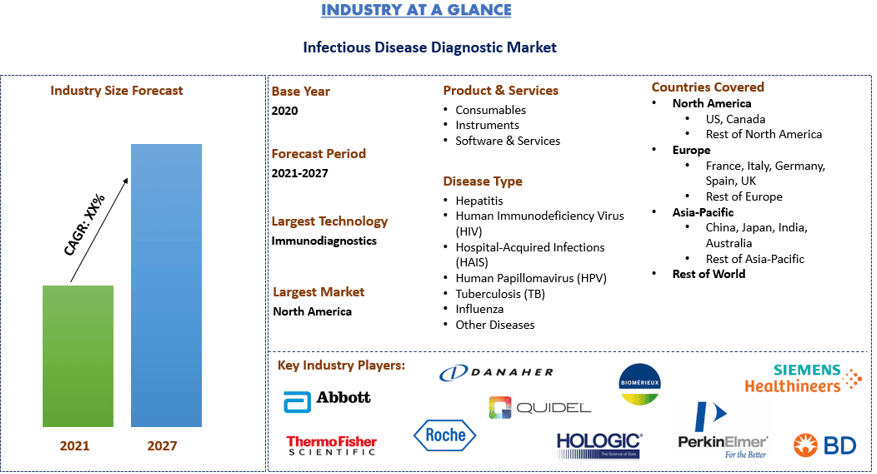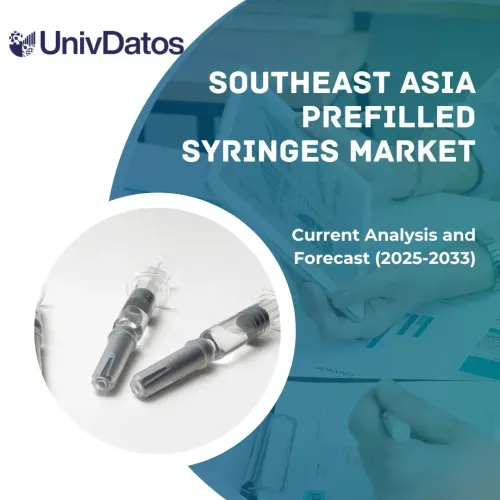- Home
- About Us
- Industry
- Services
- Reading
- Contact Us
Infectious Disease Diagnostic Market: Current Analysis and Forecast (2021-2027)
Emphasis on Product Type (Over the counter (OTC) Rapid Test Product, and Professional Rapid Test Product); Application (Infectious Disease, Cardiology, Oncology, Pregnancy & Fertility, Toxicology, Glucose Monitoring, and Others); End-User (Hospital & Clinic, Diagnostic Laboratory, Home Care, Others); and Region & Country.
Infectious Disease Diagnostic Market was valued at ~US$ 25 billion in 2020 and is expected to grow at a CAGR of ~7% over the forecast period (2021-2027). Infectious diseases are a broad term. There are a variety of illnesses and a wide number of microorganisms that can cause infectious diseases. Organisms causing infectious diseases includes parasites, bacterium, virus, or fungus. Most of these organisms are not life-threatening, however they can cause an array of illnesses training from mild to life threatening. These organisms can be transmitted from person to person by animal bites, or consuming contaminated food or water. Anyone can be affected by infectious diseases; however Immunocompromised individuals are at a greater risk of acquiring the infection. Infectious diseases can be treated with antibiotics (especially bacterial). Other infections like viral infections can be treated with antiviral medications and fungal infections can be treated with antifungals. Over time however, microorganisms are becoming resistant to drugs, thus one should always consider a doctor for the best treatment option.
The prevalence of infectious diseases has increased over the years globally. According to the World Health Organization, more than 13 million people die from infectious diseases each year. In some developing countries it leads to 1 in 2 deaths. The most vulnerable are the children, women, poor and the elderly. Infectious diseases are one of the leading cause of deaths around the world. Factors for the high occurrence of infectious diseases includes environmental, behavioral, and socio-economic factors. Additionally, migration and travel are also increasing the spread of these diseases. Infectious diseases pose significant threats to human health and can threaten international health security. To prevent this, on time diagnosis of the disease is required. This is possible with the growth of infectious disease diagnostics market.
Prevalence of Infectious Diseases According to Country Income (Number), 2019
Abbott Laboratories, F. Hoffmann-La Roche Ltd, bioMérieux SA, Thermo Fisher Scientific Inc., Danaher Corporation, Quidel Corporation, Hologic, Inc., Siemens Healthineers AG, Becton, Dickinson and Company, and PerkinElmer Inc. are some of the prominent players operating in the Infectious Disease Diagnostic market. Several M&As along with partnerships have been undertaken by these players to facilitate customers with hi-tech and innovative products/technologies.
Insights Presented in the Report
“Amongst Products & Services, Consumables segment holds the major share”
Based on product & services the infectious diseases diagnostics market is segmented into consumables, instruments, and software & services. The consumables segment is expected showed the highest revenue and is expected to grow with the highest CAGR in the coming years. One can easily get a self-testing kit for various infectious diseases and these kits are recently gaining popularity. For example, during the coronavirus, Mylab Discovery Solutions released their self-use kits for covid virus testing which could show results in 15 minutes and costed around Rs. 250. They expect to sell 50-60 million kits a month.
“Amongst Disease Type, Tuberculosis segment holds the major share”
Based on disease type, the infectious disease diagnosis market is segmented into hepatitis, human immunodeficiency virus (HIV), hospital-acquired infections (HAIS), human papillomavirus (HPV), tuberculosis (TB), influenza, and other diseases. Tuberculosis had the highest revenue among all the disease types in this segment. Tuberculosis (TB) is caused by the bacteria Mycobacterium tuberculosis which effects the lungs. In 2019, a total of 1.4 million individuals died from tuberculosis worldwide. After tuberculosis, the major infectious disease type is HIV/AIDS. As of November 2020, HIV/AIDS has claimed a total of 34.7 million lives.
“Amongst Technology, Immunodiagnostics segment holds the major share”
Based on technology, the infectious disease diagnostics market is segmented into immunodiagnostics, clinical microbiology, polymerase chain reaction, isothermal nucleic acid amplification technology, DNA sequencing and next-generation sequencing (NGS), DNA microarray technology, and other technologies. Immunodiagnostics had the highest revenue and CAGR growth in the analyzed period. Immunodiagnostics is a discipline that uses antigen-antibody reactions to detect molecules. This process can detect even a small number of molecules. This method has gained popularity in being a simple, fast, and accurate method in diagnosing a disease. This method can be used in detecting infectious diseases, autoimmune diseases, cancer, environment, food safety etc.
“Amongst End-User, Hospital/Clinical Laboratories segment holds the major share”
Based on End-User, the infectious diseases market is segmented into hospital/clinical laboratories, reference laboratories, academics/research institutes, and other end users. Hospitals/clinical laboratories earned the highest revenue in the infectious disease diagnostics market during the forecasted period. There are numerous laboratories in clinics and hospitals which specialize in performing diagnostic tests like blood tests, urine tests, throat swabs, etc. As of 2021, there are 29,227 Diagnostics and Medical Laboratories in the United States which is a 2% increase since 2020.
“North America represents one of the largest markets of Infectious Disease Diagnostic market”
For a better understanding of the market dynamics of the Infectious Disease Diagnostic market, a detailed analysis was conducted for different regions across the globe including North America (the U.S, Canada, and the Rest of North America), Europe (Germany, France, Italy, United Kingdom, Spain, and Rest of Europe), Asia-Pacific (China, Japan, India, Australia, and Rest of APAC) and Rest of the World. North America dominated the market and grabbed around XX% market share owing to growing cases of infectious diseases.
Reasons to buy this report:
- The study includes market sizing and forecasting analysis validated by authenticated key industry experts
- The report presents a quick review of overall industry performance at one glance
- The report covers an in-depth analysis of prominent industry peers with a primary focus on key business financials, product portfolio, expansion strategies, and recent developments
- Detailed examination of drivers, restraints, key trends, and opportunities prevailing in the industry
- The study comprehensively covers the market across different segments
- Deep dive regional level analysis of the industry
Customization Options:
Infectious Disease Diagnostic market can further be customized as per the requirement or any other market segment. Besides this, UMI understands that you may have your own business needs, hence feel free to connect with us to get a report that completely suits your requirements.
Table of Content
Analyzing the historical market, estimation of the current market, and forecasting the future market of the Infectious Disease Diagnostic market were the three major steps undertaken to create and analyze the adoption of Infectious Disease Diagnostic in major regions globally. Exhaustive secondary research was conducted to collect the historical market numbers and estimate the current market size. Secondly, to validate these insights, numerous findings and assumptions were taken into consideration. Moreover, exhaustive primary interviews were also conducted, with industry experts across the value chain of the Infectious Disease Diagnostic market. Post assumption and validation of market numbers through primary interviews, we employed a top-down/bottom-up approach to forecasting the complete market size. Thereafter, market breakdown and data triangulation methods were adopted to estimate and analyze the market size of segments and sub-segments the industry pertains to. Detailed methodology is explained below:
Analysis of Historical Market Size
Step 1: In-Depth Study of Secondary Sources:
Detail secondary study was conducted to obtain the historical market size of the Infectious Disease Diagnostic through company internal sources such as annual report & financial statements, performance presentations, press releases, etc., and external sources including journals, news & articles, government publications, competitor publications, sector reports, third-party database, and other credible publications.
Step 2: Market Segmentation:
After obtaining the historical market size of the Infectious Disease Diagnostic market, we conducted a detailed secondary analysis to gather historical market insights and share for different segments & sub-segments for major regions. Major segments included in the report as product & services, disease type, technology, and end-user. Further country-level analyses were conducted to evaluate the overall adoption of Infectious Disease Diagnostic in that region.
Step 3: Factor Analysis:
After acquiring the historical market size of different segments and sub-segments, we conducted a detailed factor analysis to estimate the current market size of Infectious Disease Diagnostic. Further, we conducted factor analysis using dependent and independent variables such as increasing population and thus disease transmiccion. A thorough analysis was conducted for demand and supply-side scenarios considering top partnerships, merger and acquisition, business expansion, and product launches in the Infectious Disease Diagnostic sector across the globe.
Current Market Size Estimate & Forecast
Current Market Sizing: Based on actionable insights from the above 3 steps, we arrived at the current market size, key players in the Infectious Disease Diagnostic market, and market shares of the segments. All the required percentage shares split, and market breakdowns were determined using the above-mentioned secondary approach and were verified through primary interviews.
Estimation & Forecasting: For market estimation and forecast, weights were assigned to different factors including drivers & trends, restraints, and opportunities available for the stakeholders. After analyzing these factors, relevant forecasting techniques i.e. bottom-up approach was applied to arrive at the market forecast about 2027 for different segments and subsegments across the major markets globally. The research methodology adopted to estimate the market size encompasses:
- The industry’s market size, in terms of value (US$) and the adoption rate of Infectious Disease Diagnostic across the major markets domestically
- All percentage shares, splits, and breakdowns of market segments and sub-segments
- Key players in the Infectious Disease Diagnostic market in terms of products offered. Also, the growth strategies adopted by these players to compete in the fast-growing market
Market Size and Share Validation
Primary Research: In-depth interviews were conducted with the Key Opinion Leaders (KOLs) including Top Level Executives (CXO/VPs, Sales Head, Marketing Head, Operational Head, and Regional Head, Country Head, etc.) across major regions. Primary research findings were then summarized, and statistical analysis was performed to prove the stated hypothesis. Inputs from primary research were consolidated with secondary findings, hence turning information into actionable insights.
Split of Primary Participants in Different Regions
Market Engineering
Data triangulation technique was employed to complete the overall market estimation and to arrive at precise statistical numbers of each segment and sub-segment of the Infectious Disease Diagnostic market. Data was split into several segments & sub-segments post studying various parameters and trends in the areas of type and their type of the Infectious Disease Diagnostic market.
The main objective of the Infectious Disease Diagnostic Market Study
The current & future market trends of Infectious Disease Diagnostic were pinpointed in the study. Investors can gain strategic insights to base their discretion for investments from the qualitative and quantitative analysis performed in the study. Current and future market trends were determined the overall attractiveness of the market at a regional level, providing a platform for the industrial participant to exploit the untapped market to benefit as a first-mover advantage. Other quantitative goals of the studies include:
- Analyze the current and forecast market size of Infectious Disease Diagnostic in terms of value (US$). Also, analyze the current and forecast market size of different segments and sub-segments
- Segments in the study include areas of type and their subtypes
- Define and analysis of the regulatory framework for the Infectious Disease Diagnostic industry
- Analyze the value chain involved with the presence of various intermediaries, along with analyzing customer and competitor behaviors of the industry
- Analyze the current and forecast market size of the Infectious Disease Diagnostic market for the major region
- Major regions studied in the report include North America (the U.S, Canada and Rest of North America), Europe (Germany, United Kingdom, France, Spain, Italy, and Rest of Europe), Asia-Pacific (China, Japan, India, Australia, and Others), and the Rest of the World
- Company profiles of the Infectious Disease Diagnostic market and the growth strategies adopted by the market players to sustain in the fast-growing market
- Deep dive regional level analysis of the industry
Related Reports
Customers who bought this item also bought













